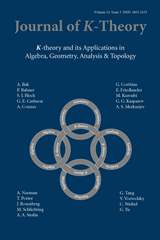No CrossRef data available.
Article contents
Algebraic cycles satisfying the Maurer-Cartan equation and the unipotent fundamental group of curves
Published online by Cambridge University Press: 04 April 2013
Abstract
We address the question of lifting the étale unipotent fundamental group of curves to the level of algebraic cycles and show that a sequence of algebraic cycles whose sum satisfies the Maurer-Cartan equation would do the job. For any elliptic curve with the origin removed and the curve  , we construct such a sequence of algebraic cycles whose image under the cycle map gives rise to the étale unipotent fundamental group of the curve.
, we construct such a sequence of algebraic cycles whose image under the cycle map gives rise to the étale unipotent fundamental group of the curve.
Keywords
- Type
- Research Article
- Information
- Copyright
- Copyright © ISOPP 2013
References
1.Beilinson, A.; Vologodsky, V.: A DG guide to Voevodsky's motives. Geom. Func. Anal. 17 (6) (2008), 1709–1787.Google Scholar
2.Bloch, S.: Some elementary theorems about algebraic cycles on abelian varieties. Inventiones Mathematicae 37 (3) (1976), 215–228.Google Scholar
3.Bloch, S.: Algebraic cycles and the Lie algebra of mixed Tate motives. J. Amer. Math. Soc. 4(4) (1991), 771–791.CrossRefGoogle Scholar
4.Bloch, S.; Kriz, I.: Mixed Tate motives. Ann. of Math. (2) 140 (3) (1994), 557–605.CrossRefGoogle Scholar
5.Deligne, P.: Cohomologie étale, Séminaire de Géométrie Algébrique du Bois-Marie, SGA 4½, avec la collaboration de J. F. Boutot, A. Grothendieck, L. Illusie et J. L. Verdier, Springer Lecture Notes in Mathematics 569, Berlin-New York 1977.Google Scholar
6.Deligne, P.: Le groupe fondamental de la droite projective moins trois points. Galois groups over ℚ. (Berkeley, CA, 1987), Math. Sci. Res. I nst. Publ. 16, Springer, New York (1989), 79–297.Google Scholar
7.Deligne, P.; Goncharov, A.: Groupes fondamentaux motiviques de Tate mixte. Ann. Sci. École Norm. Sup. (4) 38 (1) (2005), 1–56.CrossRefGoogle Scholar
8.Faltings, G.: Mathematics around Kim's new proof of Siegel's theorem. Diophantine geometry, CRM Series 4, Ed. Norm., Pisa (2007), 173–188.Google Scholar
9.Geisser, T.; Levine, M.: The Bloch-Kato conjecture and a theorem of Suslin-Voevodsky. J. Reine Angew. Math. 530 (2001), 55–103.Google Scholar
10.Hadian, M.: Motivic Fundamental Groups and Integral Points. Duke Mathematical Journal 160(3) (2011), 503–565.Google Scholar
11.Kimura, K.; Terasoma, T.: Relative DGA and mixed elliptic motives. Preprint. Available at arXiv: 1010.3791v3Google Scholar
12.Levine, M.: Tate motives and the fundamental group. Cycles, motives and Shimura varieties, Tata Inst. Fund. Res. Stud. Math. Tata Inst. Fund. Res., Mumbai (2010), 265–392.Google Scholar
13.Suslin, A., Voevodsky, V.: Relative Cycles and Chow Sheaves. Cycles, transfers, and motivic homology theories, Ann. of Math. Stud. 143, Princeton Univ. Press, Princeton, NJ, (2000), 10–86.Google Scholar
14.Voevodsky, V.: Triangulated categories of motives over a field. Cycles, transfers, and motivic homology theories, Ann. of Math. Stud. 143, Princeton Univ. Press, Princeton, NJ (2000), 188–238.Google Scholar


